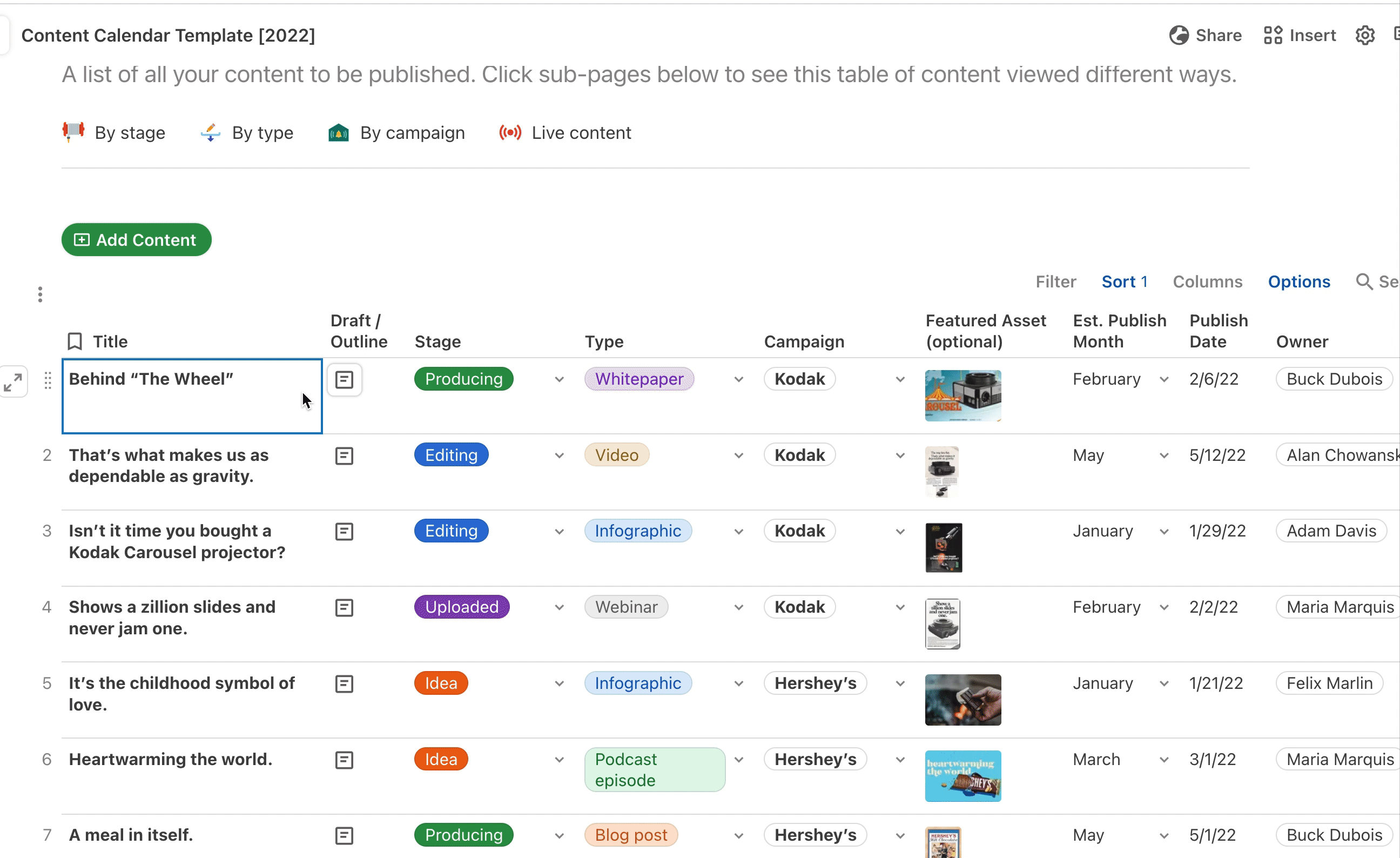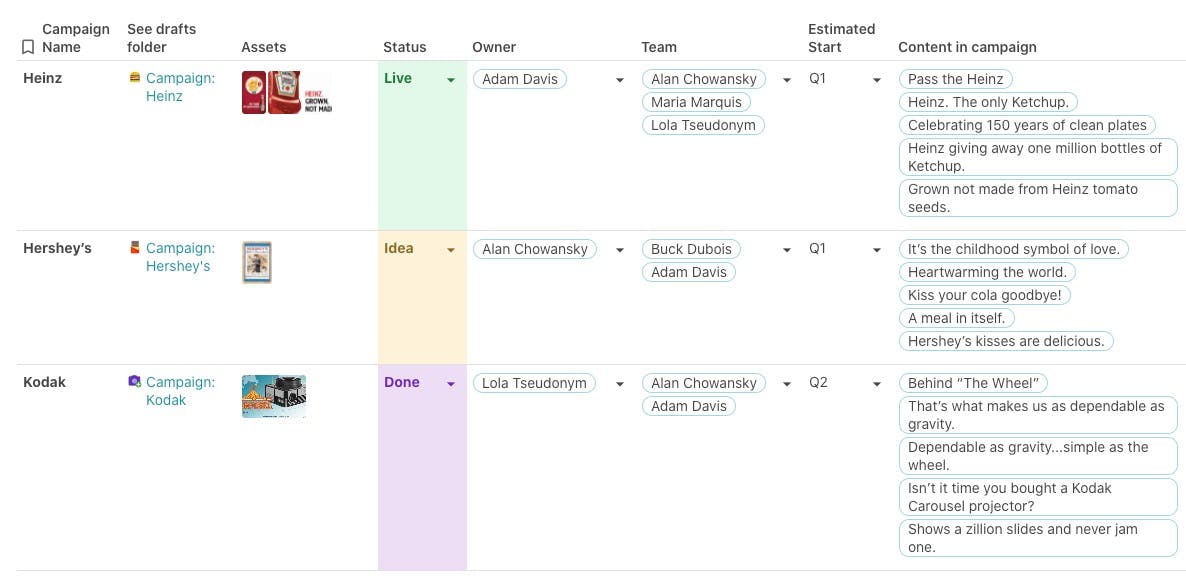
 Content Calendar Template [2025]
Content Calendar Template [2025]
A free content calendar template to make sure your content strategies and plans are executed on time in 2025. Track blog posts, podcast episodes, marketing campaigns, and more.
Start using this template:
Copy this doc
A content calendar is a system for executing your team’s content, editorial, and social media strategies.
Whether you’re a solo operation or working with a team of writers, producers, and editors, a content calendar helps you stay on track. How many pieces of content are in the “approved” stage? Which campaign does a piece of content belong to? What are the distribution channels for a piece of content? These are all questions a content calendar can help answer.
Whether you use a Google Sheet or some other online tool as your content calendar, the most important part of your content calendar is that it stays up to date and it aids your team with moving content from the idea stage to production.
I’ve been creating content (blog posts, videos, social media) for my own businesses and for Coda. I created this content calendar template based on my experience using other content calendars and put the best features from these tools into this template. This template can be used by agencies, in-house content teams, and solopreneurs who have made content a key component of their marketing strategy.
Tutorial on how to use this template:
Loading…
What is a content calendar template?
A content calendar template is a resource for your team to plan and execute a content marketing strategy. The content calendar template should be a shared collaborative resource that provides marketers with content creation, content planning, and other content workflow functionality.
Many content calendars are done in an Excel spreadsheet or Google Sheets, but these tools may be difficult to collaborate on. Your team members should be able to see and edit the content calendar template no matter where they are based. Real-time collaboration is one of the main benefits of an .
How to use a content calendar template?
I asked a few content experts about how they use their content calendars. The first theme I found is that everyone has their own unique processes for maintaining and updating their content calendars. The reasons for this variability in process results from two things: 1) content strategy might dictate certain types of content over others and 2) certain types of content do work better in the content expert’s industry.
Scheduling when content gets published is another key consideration in a content calendar. Dates will inevitably get shifted around as your colleagues might spend more time on a piece of content than originally planned. The content marketing manager at explains how their team relies on creative to deliver assets to move content through their calendar:
The content operation is mostly a 1-person show (me). The biggest bottleneck/unknown is design, which means we have to plan and work around in a way that gives the creative team enough time to create any materials we need for content.
Before creating the content calendar, some experts said you should have a solid first. Elements of a content strategy that can make their ways into a content calendar include:
, a freelance content marketing strategist, said that proper research ensures your content calendar operates smoothly:
Strategy - it’s part of the basis of an editorial calendar. It involves research - even if it’s just secondary (news outlets, Quora, etc). Your editorial calendar should be based on customer research and research with the company (e.g, what questions does the customer service team get asked and how can you use this info for content development?).
— Kirsten Lamb, Freelance Content Marketing Strategist
👉 Get started with this content calendar template Copy this doc
Copy this doc
With this template, you can make sure your publishing schedule is properly logged and tracked. Your social media marketing team also has a place to schedule their content alongside your editorial team. You might consider this if you need a more high-level way of managing your content production.
The “work” and calendar live in the same tool
Your content calendar might live in a spreadsheet or some other tool, but where does the actual work happen? You’re writing drafts in Google Docs, Wordpress, or some other CMS. Social media posts might be created in Buffer or Hootsuite. You’re then copying and pasting links to these tools into a spreadsheet.
Instead of having a sea of browser tabs open with drafts of all the blog posts you’re working on or editing, they should be “stored” in the same place as your calendar.
This template allows you to see your content drafts in your content repository and you can do all the writing, editing, and proofreading in one place. In the gif below, you’ll see the draft for the Behind the “Wheel” content by clicking the Draft / Outline icon in the page. That icon “opens up” the row where you and your content team can start writing the draft:


Variety of content types
Your for 2025 is all set. The most difficult part is tracking and executing to that strategy given all the moving parts of your strategy. Your content calendar should be flexible enough to handle all the nuances of your strategy whether you work at an agency with multiple clients or you’re working in-house for NASA.
What issues specifically should your content calendar solve? It should account for the variety of content types that your target audience wants to read and watch. While blog posts are still a great way to tell stories and good for SEO, your content calendar for 2025 should also include:
This template allows you to customize the type of content your team wants to produce. You can see the default types in the table.
Setting up this content calendar template
Every content calendar tool I came across had one thing in common: a main table with every single piece of content, no matter the stage. That’s why the in this template is the main view in this template:


Many of the dropdowns in each of these columns can be customized depending on your team’s unique content processes. You can see all the default values I’ve created in the page.
Since your content calendar will include content across multiple campaigns, I created a table just for all the over-arching campaigns your team is working on (see ). Your and are connected so you can see all the content pieces associated with one campaign:


Finally, viewing your content calendar in multiple ways is what makes this content calendar template flexible and adaptable to your team’s processes. You can view the content calendar , , , and see all (click each of these hyperlinks to go to that specific page).
Full content calendar view for 2025
Aside from the main table of all the content your team is working on, I think the main calendar view is the next most important way to visualize your content calendar.
In , you’ll see the traditional calendar layout as well as a kanban layout of your content by the “estimated publish month.” While it’s important to have an exact publish date for your content in 2025, I think visualizing your content calendar for all of 2025 helps you find gaps in your campaigns or .


Conclusion: manage content calendar and drafts in one place
While you can replicate many parts of this template in a Google Sheet or another tool, the main advantage this template offers is the ability to manage your content calendar and content drafts in one place. Along the left-hand side, you can create multiple nested pages of other work needed to execute on your content strategy:


I hope this content calendar template will set your team up for success in 2025 and beyond! 🚀
Get started with this template:
Copy this doc
⏩ Quick start
Copy this doc
Common FAQs about content calendar templates
What should a content calendar include?
The most important aspect of a content calendar is being able to plan and schedule editorial content. This means an editorial calendar template should be included in the the tool you use as your content calendar. The tool may also include a social media calendar template to assist with the scheduling and publishing of your marketing team's social media content.
The content calendar should also include due dates for when drafts, final drafts, and publish dates occur for every piece of content. Your content calendar tool may also include functionality such as content production or a place for your content repository.
What’s the difference between an editorial calendar and a content calendar?
An editorial content calendar is a plan for your content. They are associated with more traditional media like a magazine or newspaper. An editorial calendar will contain topics or themes that your editorial team will decide to write about in the coming months. It may also include holidays, seasons, and other important dates for your editorial to be aware of.
A content calendar is a shared resource so that your editorial or marketing team can all be on the same page regarding when content is published. A content calendar can contain the content from your editorial calendar as well.
Content calendar may be associated with digital forms of media like a blog, online magazine, or any business that has an online presence. Most content calendars contain a brand's editorial, blog, and social media content all in one place. This creates a unified view of all the content your team is producing and publishing.
How often should I update our content calendar?
There is no set frequency for how often you should update your calendar. A weekly cadence is quite common for most marketing teams. It's important to update your content calendar as well as existing content so that your brand's content stays fresh. There are also SEO factors for updating your content as well.
When there are important updates like product launches and company announcements, you should update your content calendar as soon as possible to start scheduling the content around this news.
A few of the 25,000+ teams that 🏃♀️ on Coda.


Coda is an all-in-one doc for your team’s unique processes — the rituals that help you succeed. Teams that use Coda get rid of hundreds of documents, spreadsheets, and even bespoke apps, to work quickly and clearly in one place. This template is a Coda doc. Click around to explore.
Find out how to Coda-fy your rituals.
Want to print your doc?
This is not the way.
This is not the way.

Try clicking the ⋯ next to your doc name or using a keyboard shortcut (
CtrlP
) instead.